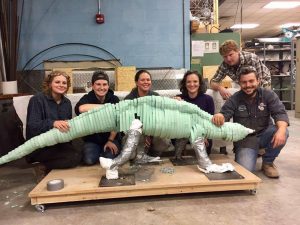The semester long Aetosaur project is finally coming into fruition. The three-dimensional model has been sculpted by Travis Donovan and his intermediate advanced sculpting class as a collaboration between the art and the geology department.
The life-sized model is a representation of the Gorgetosuchus pekinensis, an armored reptile related to, but more primitive than crocodiles, said vertebrate paleontologist and geology professor Andy Heckert.
When the model is fully completed and cast in bronze it will sit in the rock garden behind Rankin North. Heckert and his colleagues named the unknown animal Gorgetosuchus pekinensis because of the physical description of the animal.
“Gorgetosuchus comes from the French word gorget which is a term used for a medieval knight’s collar. Suchus is the Greek term for crocodile,” Heckert said. “The species name pekinensis is from the set of rocks were the fossils were found called the Pekin formation. So, the creature’s full scientific name means a neck armored crocodile from the Pekins.”
The Gorgetosuchus pekinensis is a part of the Aetosaur family which is a branch of prehistoric reptiles that can only be found in North Carolina. In the spring of last semester Lauren Waterworth, professor of environmental law, proposed the idea to Heckert as a collaborative effort between the art and geology department.
“Last year around this time I just had brainstorm, wouldn’t it be cool if we had a dinosaur sculpture here,” Waterworth said. “So I went to Dr. Heckert and said ‘we should build a dinosaur’ and his response was, ‘I can get onboard with that.’”
Through applications for internal grants the geology department was able to secure $1,600 which was enough for the cost of building the model. This task was done by Travis Donovan and his intermediate advanced sculpting class. Donovan is a visiting assistant professor for the art department in sculpturing.
The animal was found by Heckert and colleagues in Triassic basins in North Carolina. He and his colleagues from the Museum of Natural Sciences in Raleigh got permission to go into rock quarries that were used as brick plants.

“They had found a fossil in a football sized piece of rock,” Heckert said. “In it was armor that looked as though it was wadded up, like someone had left it there.”
He took the armor pieces found and constructed three-dimensional models. He then wrote a paper on his findings which was reviewed and confirmed. From there he was able to name the new species of Aetosaur.
“Dr. Heckert had done some three-dimensional printing of the neck armor for the animal that he wanted to look more realistic,” Waterworth said. “He had me paint them and while I was doing so I stumbled on a video of the Peabody museum at Yale that has a big triceratops sculpture and I thought wouldn’t that be cool if we had one of those.”
The process of building the sculpture was an interstate venture through previous connection between Heckert and a coworker from The Natural History Museums in New Mexico. Museum exhibit designer Matt Celeskey drew the two-dimensional design for the model and then worked with the intermediate advanced sculpture students to create the three-dimensional model.
“After we received the two-dimensional design we then got a program to turn it into a three-dimensional model,” senior art education and sculpting major Hunter Hill, who is also the lead sculpture in the Aetosaur project, said. “After we did that we then exported that into another three-dimensional software designing model that was able to communicate with our C&C router.”
The C&C router is an industrial sized three-dimensional printer that was able to split the model into slices.
“We then put the slices onto an armature and put the slices together,” Hill said. “The whole process took about a month and a half.”
The next step is getting more funding to have the model cast in bronze.
“The big challenge is to have it cast in bronze and that is going to take about 40,000 dollars,” Waterworth said. “So, we have a few grants we are in process of applying for and we are going to have a fundraiser style auction in April to raise money for it as well.”
Both departments said they enjoyed working with one another and said that there will be future projects between the two.
“It’s hard to communicate with someone about sculpting who really isn’t sculpture minded, but I feel like it was a really good experience for both us,” Hill said.
The intermediate advances sculpting class headed by Donovan has created a new proposal for a class that would take on projects with other departments and outside clients. One of the projects include a rock climbing wall that also has a geological information listing, but getting funding for the Aetosaur project is most immediate, Waterworth said.
Heckert said he feels that the finished project would not only be a great aesthetic piece for the rock garden, but will also teach students about the world we live in.
“I would like people to realize that the planet is really old and it changes and life changes,” he said.
